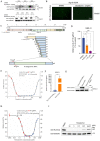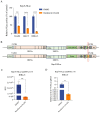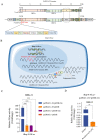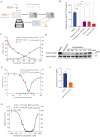Development of a Cell Culture Model for Inducible SARS-CoV-2 Replication
- PMID: 38793589
- PMCID: PMC11125939
- DOI: 10.3390/v16050708
Development of a Cell Culture Model for Inducible SARS-CoV-2 Replication
Abstract
Severe acute respiratory syndrome coronavirus 2 (SARS-CoV-2) induces direct cytopathic effects, complicating the establishment of low-cytotoxicity cell culture models for studying its replication. We initially developed a DNA vector-based replicon system utilizing the CMV promoter to generate a recombinant viral genome bearing reporter genes. However, this system frequently resulted in drug resistance and cytotoxicity, impeding model establishment. Herein, we present a novel cell culture model with SARS-CoV-2 replication induced by Cre/LoxP-mediated DNA recombination. An engineered SARS-CoV-2 transcription unit was subcloned into a bacterial artificial chromosome (BAC) vector. To enhance biosafety, the viral spike protein gene was deleted, and the nucleocapsid gene was replaced with a reporter gene. An exogenous sequence was inserted within NSP1 as a modulatory cassette that is removable after Cre/LoxP-mediated DNA recombination and subsequent RNA splicing. Using the PiggyBac transposon strategy, the transcription unit was integrated into host cell chromatin, yielding a stable cell line capable of inducing recombinant SARS-CoV-2 RNA replication. The model exhibited sensitivity to the potential antivirals forsythoside A and verteporfin. An innovative inducible SARS-CoV-2 replicon cell model was introduced to further explore the replication and pathogenesis of the virus and facilitate screening and assessment of anti-SARS-CoV-2 therapeutics.
Keywords: inducible model; replicon; severe acute respiratory syndrome coronavirus 2.
Conflict of interest statement
The authors declare no conflicts of interest.
Figures






Similar articles
-
A BSL-2 compliant mouse model of SARS-CoV-2 infection for efficient and convenient antiviral evaluation.J Virol. 2024 Jul 23;98(7):e0050424. doi: 10.1128/jvi.00504-24. Epub 2024 Jun 20. J Virol. 2024. PMID: 38899934 Free PMC article.
-
Rescue of SARS-CoV-2 from a Single Bacterial Artificial Chromosome.mBio. 2020 Sep 25;11(5):e02168-20. doi: 10.1128/mBio.02168-20. mBio. 2020. PMID: 32978313 Free PMC article.
-
Construction of a Noninfectious SARS-CoV-2 Replicon for Antiviral-Drug Testing and Gene Function Studies.J Virol. 2021 Aug 25;95(18):e0068721. doi: 10.1128/JVI.00687-21. Epub 2021 Aug 25. J Virol. 2021. PMID: 34191580 Free PMC article.
-
Generation of SARS-CoV-2 reporter replicon for high-throughput antiviral screening and testing.Proc Natl Acad Sci U S A. 2021 Apr 13;118(15):e2025866118. doi: 10.1073/pnas.2025866118. Proc Natl Acad Sci U S A. 2021. PMID: 33766889 Free PMC article.
-
Next Generation RNA/Protein-Carrying Vector With Pleiotropic Activity.Rev Med Virol. 2024 Nov;34(6):e70008. doi: 10.1002/rmv.70008. Rev Med Virol. 2024. PMID: 39488720 Review.
Cited by
-
FDA-approved drug repurposing screen identifies inhibitors of SARS-CoV-2 pseudovirus entry.Front Pharmacol. 2025 Mar 17;16:1537912. doi: 10.3389/fphar.2025.1537912. eCollection 2025. Front Pharmacol. 2025. PMID: 40166473 Free PMC article.
-
Novel Antiviral Agents: Synthesis, Molecular Modelling Studies and Biological Investigation, 2nd Edition.Viruses. 2025 Apr 23;17(5):601. doi: 10.3390/v17050601. Viruses. 2025. PMID: 40431614 Free PMC article.
References
MeSH terms
Substances
Grants and funding
LinkOut - more resources
Full Text Sources
Miscellaneous

